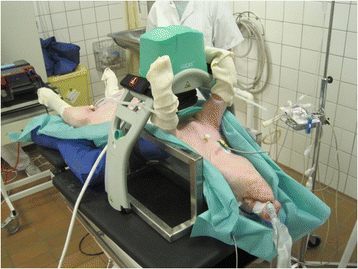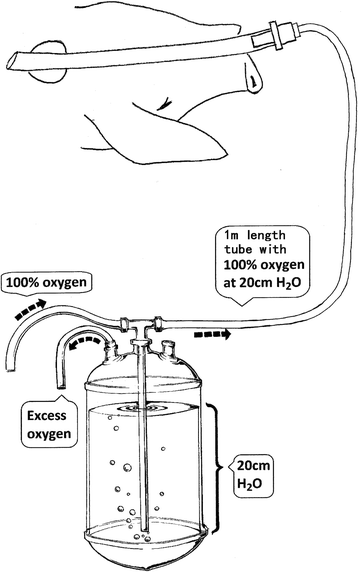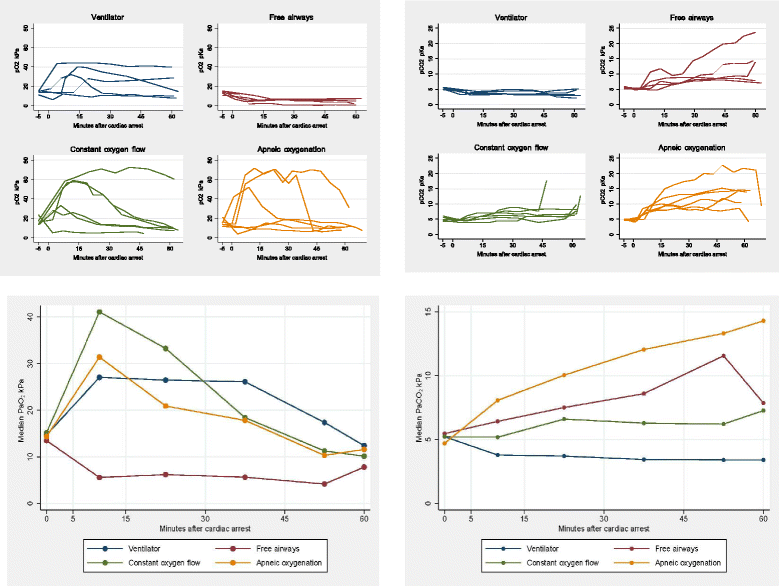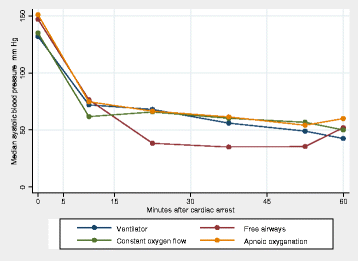Four ways to ventilate during cardiopulmonary resuscitation in a porcine model: a randomized study
- PMID: 27165087
- PMCID: PMC4862194
- DOI: 10.1186/s13049-016-0262-z
Four ways to ventilate during cardiopulmonary resuscitation in a porcine model: a randomized study
Abstract
Background: The optimal method for out-of-hospital ventilation during cardiopulmonary rescue (CPR) is controversial. The aim of this study was to test different modes of ventilation during CPR for a prolonged period of 60 min.
Methods: Pigs were randomized to four groups after the induction of ventricular fibrillation, which was followed by one hour of mechanical cardiac compressions. The study comprised five pigs treated with free airways, five pigs treated with ventilators, six pigs treated with a constant oxygen flow into the tube, and six pigs treated with apnoeic oxygenation.
Results: The free airway group was tested for 1 h, but in the first 15 min, the median PaO2 had already dropped to 5.1 kPa. The ventilator group was tested for 1 h and still had an acceptable median PaO2 of 10.3 kPa in the last 15 min. The group was slightly hyperventilated, with PaCO2 at 3.8 kPa, even though the ventilator volumes were unchanged from those before induction of cardiac arrest. In the group with constant oxygen flowing into the tube, one pig was excluded after 47 min due to blood pressure below 25 mmHg. For the remaining 5 pigs, the median PaO2 in the last 15 min was still 14.3 kPa, and the median PaCO2 was 6.2 kPa. The group with apnoeic oxygenation for 1 h had a resulting median PaO2 of 10.2 kPa and a median PaCO2 of 12.3 kPa in the last 15 min.
Discussion: Except for the free airway group, the other methods resulted in PaO2 above 10 kPa and PaCO2 between 3.8 and 12.3 kPa after one hour.
Conclusion: Constant oxgen flow and apnoeic oxygenation seemed to be useable alternatives to ventilator treatment.
Keywords: CPR; Cardiac arrest; Ventilation methods.
Figures





Similar articles
-
The effects of an automatic, low pressure and constant flow ventilation device versus manual ventilation during cardiovascular resuscitation in a porcine model of cardiac arrest.Resuscitation. 2013 Aug;84(8):1150-5. doi: 10.1016/j.resuscitation.2013.02.017. Epub 2013 Feb 27. Resuscitation. 2013. PMID: 23454260
-
A randomized comparison of cardiocerebral and cardiopulmonary resuscitation using a swine model of prolonged ventricular fibrillation.Resuscitation. 2010 May;81(5):596-602. doi: 10.1016/j.resuscitation.2010.01.013. Epub 2010 Feb 21. Resuscitation. 2010. PMID: 20176434
-
Chest Compression Synchronized Ventilation versus Intermitted Positive Pressure Ventilation during Cardiopulmonary Resuscitation in a Pig Model.PLoS One. 2015 May 26;10(5):e0127759. doi: 10.1371/journal.pone.0127759. eCollection 2015. PLoS One. 2015. PMID: 26011525 Free PMC article.
-
[Ventilation during cardiopulmonary resuscitation (CPR). A literature study and analysis of ventilation strategies].Anaesthesist. 1997 Feb;46(2):133-41. doi: 10.1007/s001010050383. Anaesthesist. 1997. PMID: 9133175 Review. German.
-
When should rescue breathing be removed from the ABCs of CPR?Crit Care Clin. 2012 Apr;28(2):155-65. doi: 10.1016/j.ccc.2011.12.001. Epub 2012 Feb 1. Crit Care Clin. 2012. PMID: 22433480 Review. No abstract available.
Cited by
-
Efficacy of Manual Ventilation Techniques During Cardiopulmonary Resuscitation in Dogs.Front Vet Sci. 2018 Oct 1;5:239. doi: 10.3389/fvets.2018.00239. eCollection 2018. Front Vet Sci. 2018. PMID: 30327772 Free PMC article.
-
[Paediatric Life Support].Notf Rett Med. 2021;24(4):650-719. doi: 10.1007/s10049-021-00887-9. Epub 2021 Jun 2. Notf Rett Med. 2021. PMID: 34093080 Free PMC article. Review. German.
-
Bi-Level ventilation decreases pulmonary shunt and modulates neuroinflammation in a cardiopulmonary resuscitation model.PeerJ. 2020 Apr 29;8:e9072. doi: 10.7717/peerj.9072. eCollection 2020. PeerJ. 2020. PMID: 32377456 Free PMC article.
References
-
- Wik L, Olsen JA, Persse D, Sterz F, Lozano M, Jr, Brouwer MA, et al. Manual vs. integrated automatic load-distributing band CPR with equal survival after out of hospital cardiac arrest. The randomized CIRC trial. Resuscitation. 2014;85(6):741–8. doi: 10.1016/j.resuscitation.2014.03.005. - DOI - PubMed
-
- Nolan JP, Soar J, Cariou A, Cronberg T, Moulaert VR, Deakin CD, et al. European Resuscitation Council and European Society of Intensive Care Medicine Guidelines for Post-resuscitation Care 2015: Section 5 of the European Resuscitation Council Guidelines for Resuscitation 2015. Resuscitation. 2015;95:202–22. doi: 10.1016/j.resuscitation.2015.07.018. - DOI - PubMed
-
- Maertens VL, De Smedt LE, Lemoyne S, Huybrechts SA, Wouters K, Kalmar AF, et al. Patients with cardiac arrest are ventilated two times faster than guidelines recommend: an observational prehospital study using tracheal pressure measurement. Resuscitation. 2013;84(7):921–6. doi: 10.1016/j.resuscitation.2012.11.015. - DOI - PubMed
MeSH terms
LinkOut - more resources
Full Text Sources
Other Literature Sources
Medical

